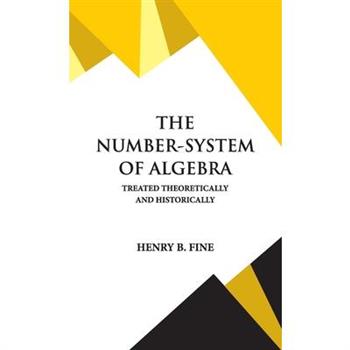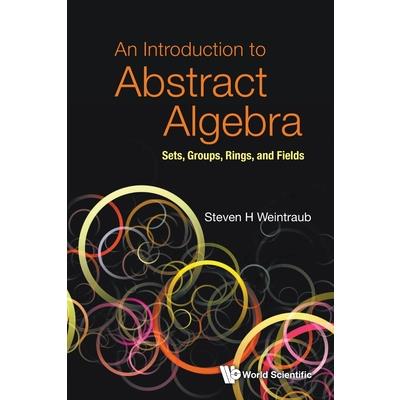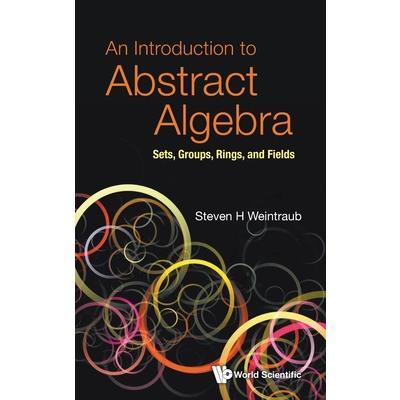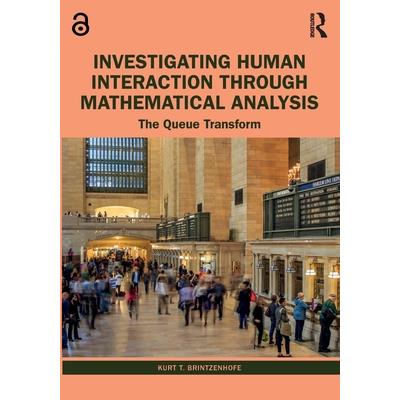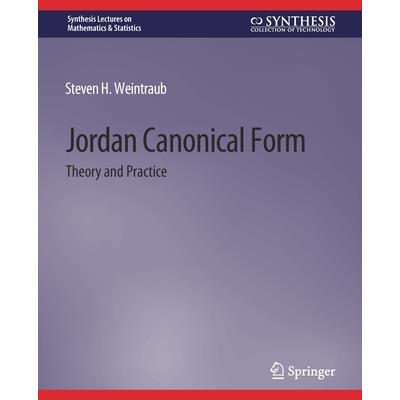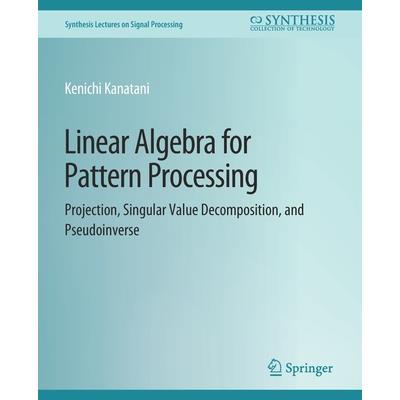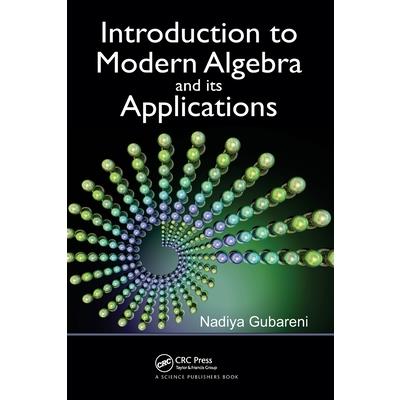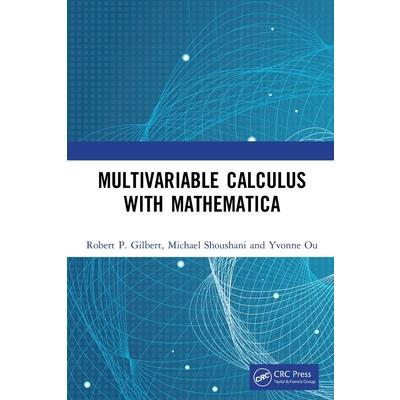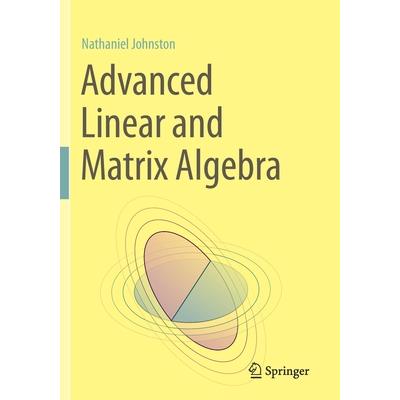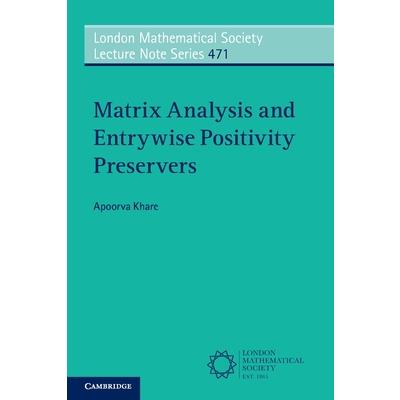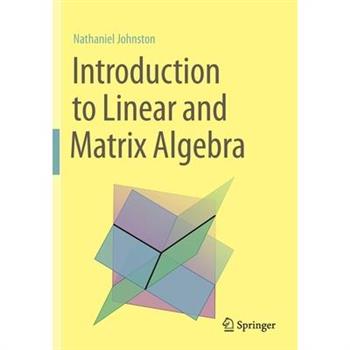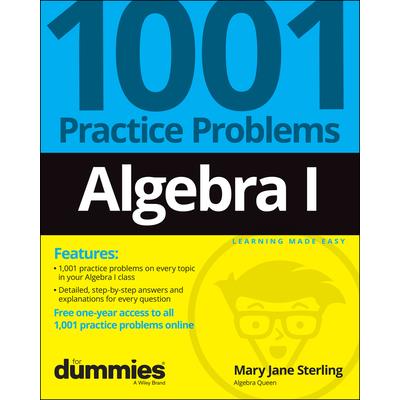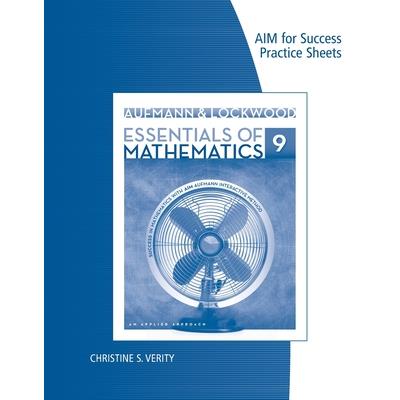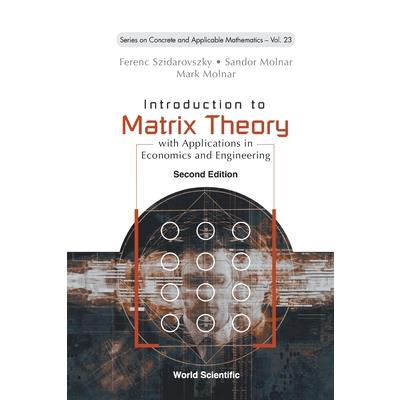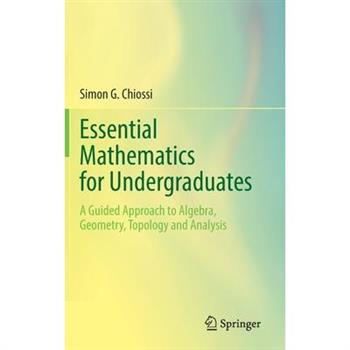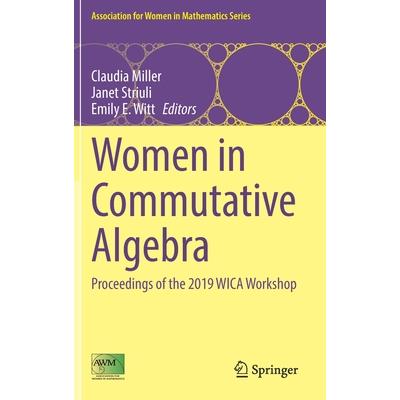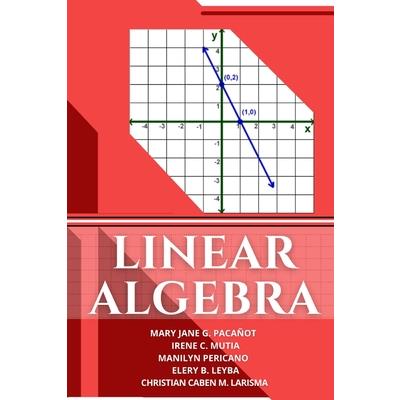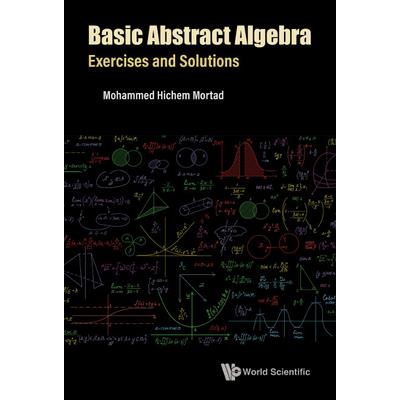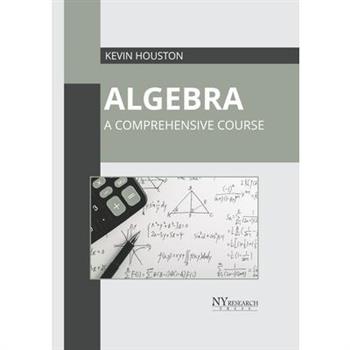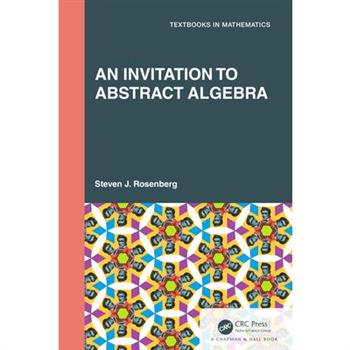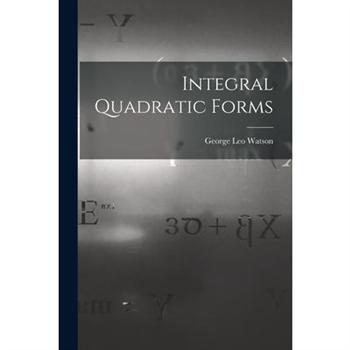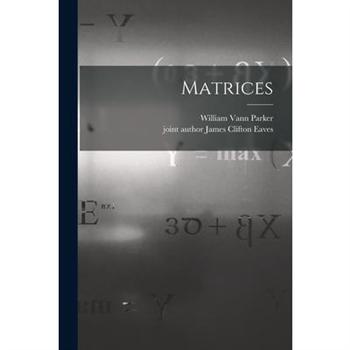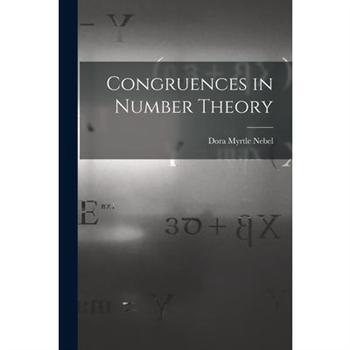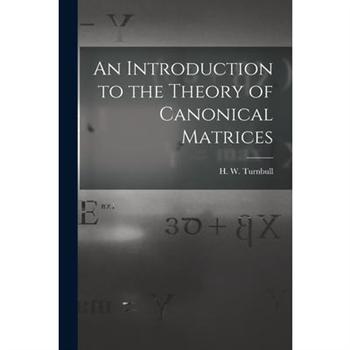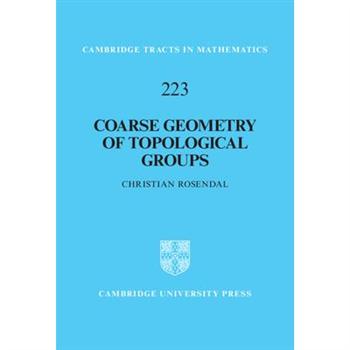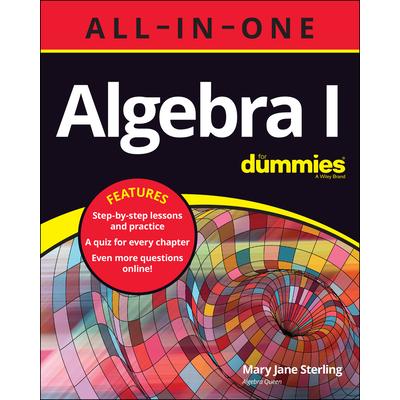Linear Algebra
The purpose of this book is to explain linear algebra clearly for beginners. In doing so, the author states and explains somewhat advanced topics such as Hermitian products and Jordan normal forms. Starting from the definition of matrices, it is made clear with examples that matrices and matrix operation are abstractions of tables and operations of tables. The author also maintains that systems of linear equations are the starting point of linear algebra, and linear algebra and linear equations are closely connected. The solutions to systems of linear equations are found by solving matrix equations in the row-reduction of matrices, equivalent to the Gauss elimination method of solving systems of linear equations. The row-reductions play important roles in calculation in this book. To calculate row-reductions of matrices, the matrices are arranged vertically, which is seldom seen but is convenient for calculation. Regular matrices and determinants of matrices are defined and explained. Furthermore, the resultants of polynomials are discussed as an application of determinants. Next, abstract vector spaces over a field K are defined. In the book, however, mainly vector spaces are considered over the real number field and the complex number field, in case readers are not familiar with abstract fields. Linear mappings and linear transformations of vector spaces and representation matrices of linear mappings are defined, and the characteristic polynomials and minimal polynomials are explained. The diagonalizations of linear transformations and square matrices are discussed, and inner products are defined on vector spaces over the real number field. Real symmetric matrices are considered as well, with discussion of quadratic forms. Next, there are definitions of Hermitian inner products. Hermitian transformations, unitary transformations, normal transformations and the spectral resolution of normal transformations and matrices are explained. The book ends withJordan normal forms. It is shown that any transformations of vector spaces over the complex number field have matrices of Jordan normal forms as representation matrices.
Quaternion Algebras
This open access textbook presents a comprehensive treatment of the arithmetic theory of quaternion algebras and orders, a subject with applications in diverse areas of mathematics. Written to be accessible and approachable to the graduate student reader, this text collects and synthesizes results from across the literature. Numerous pathways offer explorations in many different directions, while the unified treatment makes this book an essential reference for students and researchers alike. Divided into five parts, the book begins with a basic introduction to the noncommutative algebra underlying the theory of quaternion algebras over fields, including the relationship to quadratic forms. An in-depth exploration of the arithmetic of quaternion algebras and orders follows. The third part considers analytic aspects, starting with zeta functions and then passing to an idelic approach, offering a pathway from local to global that includes strong approximation. Applications of unitgroups of quaternion orders to hyperbolic geometry and low-dimensional topology follow, relating geometric and topological properties to arithmetic invariants. Arithmetic geometry completes the volume, including quaternionic aspects of modular forms, supersingular elliptic curves, and the moduli of QM abelian surfaces. Quaternion Algebras encompasses a vast wealth of knowledge at the intersection of many fields. Graduate students interested in algebra, geometry, and number theory will appreciate the many avenues and connections to be explored. Instructors will find numerous options for constructing introductory and advanced courses, while researchers will value the all-embracing treatment. Readers are assumed to have some familiarity with algebraic number theory and commutative algebra, as well as the fundamentals of linear algebra, topology, and complex analysis. More advanced topics call upon additional background, as noted, though essential concepts andmotivation are recapped throughout.
Abstract Algebra
When a student of mathematics studies abstract algebra, he or she inevitably faces questions in the vein of, "What is abstract algebra" or "What makes it abstract?" Algebra, in its broadest sense, describes a way of thinking about classes of sets equipped with binary operations. In high school algebra, a student explores properties of operations (+, -, ?, and 繩) on real numbers. Abstract algebra studies properties of operations without specifying what types of number or object we work with. Any theorem established in the abstract context holds not only for real numbers but for every possible algebraic structure that has operations with the stated properties. This textbook intends to serve as a first course in abstract algebra. The selection of topics serves both of the common trends in such a course: a balanced introduction to groups, rings, and fields; or a course that primarily emphasizes group theory. The writing style is student-centered, conscientiously motivating definitions and offering many illustrative examples. Various sections or sometimes just examples or exercises introduce applications to geometry, number theory, cryptography and many other areas. This book offers a unique feature in the lists of projects at the end of each section. the author does not view projects as just something extra or cute, but rather an opportunity for a student to work on and demonstrate their potential for open-ended investigation. The projects ideas come in two flavors: investigative or expository. The investigative projects briefly present a topic and posed open-ended questions that invite the student to explore the topic, asking and to trying to answer their own questions. Expository projects invite the student to explore a topic with algebraic content or pertain to a particular mathematician's work through responsible research. The exercises challenge the student to prove new results using the theorems presented in the text. The student then becomes an active participant in the development of the field.
Leibniz Algebras
Leibniz Algebras: Structure and Classification is designed to introduce the reader to the theory of Leibniz algebras. Leibniz algebra is the generalization of Lie algebras. These algebras preserve a unique property of Lie algebras that the right multiplication operators are derivations. They first appeared in papers of A.M Blokh in the 1960s, under the name D-algebras, emphasizing their close relationship with derivations. The theory of D-algebras did not get as thorough an examination as it deserved immediately after its introduction. Later, the same algebras were introduced in 1993 by Jean-Louis Loday, who called them Leibniz algebras due to the identity they satisfy. The main motivation for the introduction of Leibniz algebras was to study the periodicity phenomena in algebraic K-theory. Nowadays, the theory of Leibniz algebras is one of the more actively developing areas of modern algebra. Along with (co)homological, structural and classification results on Leibniz algebras, some papers with various applications of the Leibniz algebras also appear now. However, the focus of this book is mainly on the classification problems of Leibniz algebras. Particularly, the authors propose a method of classification of a subclass of Leibniz algebras based on algebraic invariants. The method is applicable in the Lie algebras case as well. Features: Provides a systematic exposition of the theory of Leibniz algebras and recent results on Leibniz algebras Suitable for final year bachelor's students, master's students and PhD students going into research in the structural theory of finite-dimensional algebras, particularly, Lie and Leibniz algebras Covers important and more general parts of the structural theory of Leibniz algebras that are not addressed in other texts
Linear Algebra
This text is written for a course in linear algebra at the (U.S.) sophomore undergraduate level, preferably directly following a one-variable calculus course, so that linear algebra can be used in a course on multidimensional calculus. Realizing that students at this level have had little contact with complex numbers or abstract mathematics the book deals almost exclusively with real finite-dimensional vector spaces in a setting and formulation that permits easy generalization to abstract vector spaces. The parallel complex theory is developed in the exercises. The book has as a goal the principal axis theorem for real symmetric transformations, and a more or less direct path is followed. As a consequence there are many subjects that are not developed, and this is intentional. However a wide selection of examples of vector spaces and linear trans- formations is developed, in the hope that they will serve as a testing ground for the theory. The book is meant as an introduction to linear algebra and the theory developed contains the essentials for this goal. Students with a need to learn more linear algebra can do so in a course in abstract algebra, which is the appropriate setting. Through this book they will be taken on an excursion to the algebraic/analytic zoo, and introduced to some of the animals for the first time. Further excursions can teach them more about the curious habits of some of these remarkable creatures.
Generalized B*-Algebras and Applications
1. Introduction.- 2. A Spectral Theory for Locally Convex Algebras.- 3. Generalized B*-Algebras: Functional Representation Theory.- 4. Commutative Generalized B*-Algebras: Functional Calculus and Equivalent Topologies.- 5. Extended C*-Algebras and Extended W*-Algebras.- 6. Generalized B*-Algebras: Unbounded *-Representation Theory.- 7. Applications I: Miscellanea.- 8. Applications II: Tensor Products.
The Number-System of Algebra
I THEORETICAL1. THE POSITIVE INTEGER, AND THE LAWS WHICH REGULATE THE ADDITION AND MULTIPLICATION OF POSITIVE INTEGERS.2. SUBTRACTION AND THE NEGATIVE INTEGER.3. DIVISION AND THE FRACTION.4. THE IRRATIONAL5. THE IMAGINARY COMPLEX NUMBERS.6. GRAPHICAL REPRESENTATION OF NUMBERS. THE VARIABLE.7. THE FUNDAMENTAL THEOREM OF ALGEBRA.8. INFINITE SERIES.9. THE EXPONENTIAL AND LOGARITHMIC FUNCTIONS UNDETERMINED COEFFICIENTS INVOLUTION AND EVOLUTION. THE BINOMIAL THEOREM HISTORICAL 10. PRIMITIVE NUMERALS.11. HISTORIC SYSTEMS OF NOTATION.12. THE FRACTION.13. ORIGIN OF THE IRRATIONAL14. ORIGIN OF THE NEGATIVE AND THE IMAGINARY THE EQUATION.15. ACCEPTANCE OF THE NEGATIVE, THE GENERAL IRRATIONAL, AND THE IMAGINARY AS NUMBERS.16. RECOGNITION OF THE PURELY SYMBOLIC CHARACTER OF ALGEBRA. QUATERNIONS. AUSDEHNUNGSLEHRE.
Cherlin’s Conjecture for Finite Primitive Binary Permutation Groups
This book gives a proof of Cherlin's conjecture for finite binary primitive permutation groups. Motivated by the part of model theory concerned with Lachlan's theory of finite homogeneous relational structures, this conjecture proposes a classification of those finite primitive permutation groups that have relational complexity equal to 2. The first part gives a full introduction to Cherlin's conjecture, including all the key ideas that have been used in the literature to prove some of its special cases. The second part completes the proof by dealing with primitive permutation groups that are almost simple with socle a group of Lie type. A great deal of material concerning properties of primitive permutation groups and almost simple groups is included, and new ideas are introduced. Addressing a hot topic which cuts across the disciplines of group theory, model theory and logic, this book will be of interest toa wide range of readers. It will be particularly useful for graduate students and researchers who need to work with simple groups of Lie type.
Introduction to Abstract Algebra, An: Sets, Groups, Rings, and Fields
This book is a textbook for a semester-long or year-long introductory course in abstract algebra at the upper undergraduate or beginning graduate level.It treats set theory, group theory, ring and ideal theory, and field theory (including Galois theory), and culminates with a treatment of Dedekind rings, including rings of algebraic integers.In addition to treating standard topics, it contains material not often dealt with in books at this level. It provides a fresh perspective on the subjects it covers, with, in particular, distinctive treatments of factorization theory in integral domains and of Galois theory.As an introduction, it presupposes no prior knowledge of abstract algebra, but provides a well-motivated, clear, and rigorous treatment of the subject, illustrated by many examples. Written with an eye toward number theory, it contains numerous applications to number theory (including proofs of Fermat's theorem on sums of two squares and of the Law of Quadratic Reciprocity) and serves as an excellent basis for further study in algebra in general and number theory in particular.Each of its chapters concludes with a variety of exercises ranging from the straightforward to the challenging in order to reinforce students' knowledge of the subject. Some of these are particular examples that illustrate the theory while others are general results that develop the theory further.
Introduction to Abstract Algebra, An: Sets, Groups, Rings, and Fields
This book is a textbook for a semester-long or year-long introductory course in abstract algebra at the upper undergraduate or beginning graduate level.It treats set theory, group theory, ring and ideal theory, and field theory (including Galois theory), and culminates with a treatment of Dedekind rings, including rings of algebraic integers.In addition to treating standard topics, it contains material not often dealt with in books at this level. It provides a fresh perspective on the subjects it covers, with, in particular, distinctive treatments of factorization theory in integral domains and of Galois theory.As an introduction, it presupposes no prior knowledge of abstract algebra, but provides a well-motivated, clear, and rigorous treatment of the subject, illustrated by many examples. Written with an eye toward number theory, it contains numerous applications to number theory (including proofs of Fermat's theorem on sums of two squares and of the Law of Quadratic Reciprocity) and serves as an excellent basis for further study in algebra in general and number theory in particular.Each of its chapters concludes with a variety of exercises ranging from the straightforward to the challenging in order to reinforce students' knowledge of the subject. Some of these are particular examples that illustrate the theory while others are general results that develop the theory further.
Investigating Human Interaction Through Mathematical Analysis
Investigating Human Interaction through Mathematical Analysis offers a new and unique approach to social intragroup interaction by using mathematics and psychophysics to create a mathematical model based on social psychological theories.It draws on the work of Dr. Stanley Milgram, Dr. Bibb Latane, and Dr. Bernd Schmitt to develop an algebraic expression and applies it to quantitatively model and explain various independent social psychology experiments taken from refereed journals involving basic social systems with underlying queue-like structures. It is then argued that the social queue as a resource system, containing common-pool resources, meets the eight design principles necessary to support stability within the queue. Making this link provides a means to advance to more complex social systems. It is envisioned that if basic social systems as presented can be modeled, then, with further development, more complex social systems may eventually be modeled for the purpose of identifying and validating social structures that might eventually support stable governments in our common environment called Earth.This is a fascinating reading for academics and advanced students interested in political theory, detection theory, social psychology, organizational behavior, psychophysics, and applied mathematics in the social and information sciences.The Open Access version of this book, available at www.taylorfrancis.com, has been made available under a Creative Commons Attribution-Non Commercial-No Derivatives 4.0 license.
Jordan Canonical Form
Jordan Canonical Form (JCF) is one of the most important, and useful, concepts in linear algebra. The JCF of a linear transformation, or of a matrix, encodes all of the structural information about that linear transformation, or matrix. This book is a careful development of JCF. After beginning with background material, we introduce Jordan Canonical Form and related notions: eigenvalues, (generalized) eigenvectors, and the characteristic and minimum polynomials. We decide the question of diagonalizability, and prove the Cayley-Hamilton theorem. Then we present a careful and complete proof of the fundamental theorem: Let V be a finite-dimensional vector space over the field of complex numbers C, and let T: V → V be a linear transformation. Then T has a Jordan Canonical Form. This theorem has an equivalent statement in terms of matrices: Let A be a square matrix with complex entries. Then A is similar to a matrix J in Jordan Canonical Form, i.e., there is an invertible matrix P and a matrix J in Jordan Canonical Form with A = PJP-1. We further present an algorithm to find P and J, assuming that one can factor the characteristic polynomial of A. In developing this algorithm we introduce the eigenstructure picture (ESP) of a matrix, a pictorial representation that makes JCF clear. The ESP of A determines J, and a refinement, the labeled eigenstructure picture (ℓESP) of A, determines P as well. We illustrate this algorithm with copious examples, and provide numerous exercises for the reader. Table of Contents: Fundamentals on Vector Spaces and Linear Transformations / The Structure of a Linear Transformation / An Algorithm for Jordan Canonical Form and Jordan Basis
Linear Algebra for Pattern Processing
Linear algebra is one of the most basic foundations of a wide range of scientific domains, and most textbooks of linear algebra are written by mathematicians. However, this book is specifically intended to students and researchers of pattern information processing, analyzing signals such as images and exploring computer vision and computer graphics applications. The author himself is a researcher of this domain. Such pattern information processing deals with a large amount of data, which are represented by high-dimensional vectors and matrices. There, the role of linear algebra is not merely numerical computation of large-scale vectors and matrices. In fact, data processing is usually accompanied with "geometric interpretation." For example, we can think of one data set being "orthogonal" to another and define a "distance" between them or invoke geometric relationships such as "projecting" some data onto some space. Such geometric concepts not only help us mentally visualize abstracthigh-dimensional spaces in intuitive terms but also lead us to find what kind of processing is appropriate for what kind of goals. First, we take up the concept of "projection" of linear spaces and describe "spectral decomposition," "singular value decomposition," and "pseudoinverse" in terms of projection. As their applications, we discuss least-squares solutions of simultaneous linear equations and covariance matrices of probability distributions of vector random variables that are not necessarily positive definite. We also discuss fitting subspaces to point data and factorizing matrices in high dimensions in relation to motion image analysis. Finally, we introduce a computer vision application of reconstructing the 3D location of a point from three camera views to illustrate the role of linear algebra in dealing with data with noise. This book is expected to help students and researchers of pattern information processing deepen the geometric understanding of linear algebra.
Introduction to Modern Algebra and Its Applications
The book provides an introduction to modern abstract algebra and its applications. It covers all major topics of classical theory of numbers, groups, rings, fields and finite dimensional algebras.
Multivariable Calculus with Mathematica
Multivariable Calculus with Mathematica is a textbook addressing the calculus of several variables. Instead of just using Mathematica to directly solve problems, the students are encouraged to learn the syntax and to write their own code to solve problems. This not only encourages scientific computing skills but at the same time stresses the complete understanding of the mathematics. Questions are provided at the end of the chapters to test the student's theoretical understanding of the mathematics, and there are also computer algebra questions which test the student's ability to apply their knowledge in non-trivial ways. Features Ensures that students are not just using the package to directly solve problems, but learning the syntax to write their own code to solve problems Suitable as a main textbook for a Calculus III course, and as a supplementary text for topics scientific computing, engineering, and mathematical physics Written in a style that engages the students' interest and encourages the understanding of the mathematical ideas
Deformation Theory of Discontinuous Groups
This book contains the latest developments of the theory of discontinuous groups acting on homogenous spaces, from basic concepts to a comprehensive exposition. It develops the newest approaches and methods in the deformation theory of topological modules and unitary representations and focuses on the geometry of discontinuous groups of solvable Lie groups and their compact extensions. It also presents proofs of recent results, computes fundamental examples, and serves as an introduction and reference for students and experienced researchers in Lie theory, discontinuous groups, and deformation (and moduli) spaces.
Advanced Linear and Matrix Algebra
This textbook emphasizes the interplay between algebra and geometry to motivate the study of advanced linear algebra techniques. Matrices and linear transformations are presented as two sides of the same coin, with their connection motivating inquiry throughout the book. Building on a first course in linear algebra, this book offers readers a deeper understanding of abstract structures, matrix decompositions, multilinearity, and tensors. Concepts draw on concrete examples throughout, offering accessible pathways to advanced techniques. Beginning with a study of vector spaces that includes coordinates, isomorphisms, orthogonality, and projections, the book goes on to focus on matrix decompositions. Numerous decompositions are explored, including the Shur, spectral, singular value, and Jordan decompositions. In each case, the author ties the new technique back to familiar ones, to create a coherent set of tools. Tensors and multilinearity complete the book, with a study of the Kronecker product, multilinear transformations, and tensor products. Throughout, "Extra Topic" sections augment the core content with a wide range of ideas and applications, from the QR and Cholesky decompositions, to matrix-valued linear maps and semidefinite programming. Exercises of all levels accompany each section. Advanced Linear and Matrix Algebra offers students of mathematics, data analysis, and beyond the essential tools and concepts needed for further study. The engaging color presentation and frequent marginal notes showcase the author's visual approach. A first course in proof-based linear algebra is assumed. An ideal preparation can be found in the author's companion volume, Introduction to Linear and Matrix Algebra.
Matrix Analysis and Entrywise Positivity Preservers
Matrices and kernels with positivity structures, and the question of entrywise functions preserving them, have been studied throughout the 20th century, attracting recent interest in connection to high-dimensional covariance estimation. This is the first book to systematically develop the theoretical foundations of the entrywise calculus, focusing on entrywise operations - or transforms - of matrices and kernels with additional structure, which preserve positive semidefiniteness. Designed as an introduction for students, it presents an in-depth and comprehensive view of the subject, from early results to recent progress. Topics include: structural results about, and classifying the preservers of positive semidefiniteness and other Loewner properties (monotonicity, convexity, super-additivity); historical connections to metric geometry; classical connections to moment problems; and recent connections to combinatorics and Schur polynomials. Based on the author's course, the book is structured for use as lecture notes, including exercises for students, yet can also function as a comprehensive reference text for experts.
Jordanus de Nemore, de Numeris Datis
This title is part of UC Press's Voices Revived program, which commemorates University of California Press's mission to seek out and cultivate the brightest minds and give them voice, reach, and impact. Drawing on a backlist dating to 1893, Voices Revived makes high-quality, peer-reviewed scholarship accessible once again using print-on-demand technology. This title was originally published in 1981.
Jordanus de Nemore, de Numeris Datis
This title is part of UC Press's Voices Revived program, which commemorates University of California Press's mission to seek out and cultivate the brightest minds and give them voice, reach, and impact. Drawing on a backlist dating to 1893, Voices Revived makes high-quality, peer-reviewed scholarship accessible once again using print-on-demand technology. This title was originally published in 1981.
Introduction to Linear and Matrix Algebra
This textbook emphasizes the interplay between algebra and geometry to motivate the study of linear algebra. Matrices and linear transformations are presented as two sides of the same coin, with their connection motivating inquiry throughout the book. By focusing on this interface, the author offers a conceptual appreciation of the mathematics that is at the heart of further theory and applications. Those continuing to a second course in linear algebra will appreciate the companion volume Advanced Linear and Matrix Algebra. Starting with an introduction to vectors, matrices, and linear transformations, the book focuses on building a geometric intuition of what these tools represent. Linear systems offer a powerful application of the ideas seen so far, and lead onto the introduction of subspaces, linear independence, bases, and rank. Investigation then focuses on the algebraic properties of matrices that illuminate the geometry of the linear transformations that they represent. Determinants, eigenvalues, and eigenvectors all benefit from this geometric viewpoint. Throughout, "Extra Topic" sections augment the core content with a wide range of ideas and applications, from linear programming, to power iteration and linear recurrence relations. Exercises of all levels accompany each section, including many designed to be tackled using computer software. Introduction to Linear and Matrix Algebra is ideal for an introductory proof-based linear algebra course. The engaging color presentation and frequent marginal notes showcase the author's visual approach. Students are assumed to have completed one or two university-level mathematics courses, though calculus is not an explicit requirement. Instructors will appreciate the ample opportunities to choose topics that align with the needs of each classroom, and the online homework sets that are available through WeBWorK.
Algebra I: 1001 Practice Problems for Dummies (+ Free Online Practice)
Practice your way to a great grade in Algebra I Algebra I: 1001 Practice Problems For Dummies gives you 1,001 opportunities to practice solving problems on all the major topics in Algebra I--in the book and online! Get extra help with tricky subjects, solidify what you've already learned, and get in-depth walk-throughs for every problem with this useful book. These practice problems and detailed answer explanations will get you solving for x in no-time, no matter what your skill level. Thanks to Dummies, you have a resource to you put key concepts into practice. Work through practice problems on all Algebra I topics covered in class Step through detailed solutions for every problem to build your understanding Access practice questions online to study anywhere, any time Improve your grade and up your study game with practice, practice, practiceThe material presented in Algebra I: 1001 Practice Problems For Dummies is an excellent resource for students, as well as parents and tutors looking to help supplement classroom instruction. Algebra I: 1001 Practice Problems For Dummies (9781119883470) was previously published as 1,001 Algebra I Practice Problems For Dummies (9781118446713). While this version features a new Dummies cover and design, the content is the same as the prior release and should not be considered a new or updated product.
Practical Algebra
The most practical, complete, and accessible guide for understanding algebra If you want to make sense of algebra, check out Practical Algebra: A Self-Teaching Guide. Written by two experienced classroom teachers, this Third Edition is completely revised to align with the Common Core Algebra I math standards used in many states. You'll get an overview of solving linear and quadratic equations, using ratios and proportions, decoding word problems, graphing and interpreting functions, modeling the real world with statistics, and other concepts found in today's algebra courses. This book also contains a brief review of pre-algebra topics, including arithmetic and fractions. It has concrete strategies that help diverse students to succeed, such as: over 500 images and tables that illustrate important concepts over 200 model examples with complete solutions almost 1,500 exercises with answers so you can monitor your progressPractical Algebra emphasizes making connections to what you already know and what you'll learn in the future. You'll learn to see algebra as a logical and consistent system of ideas and see how it connects to other mathematical topics. This book makes math more accessible by treating it as a language. It has tips for pronouncing and using mathematical notation, a glossary of commonly used terms in algebra, and a glossary of symbols. Along the way, you'll discover how different cultures around the world over thousands of years developed many of the mathematical ideas we use today. Since students nowadays can use a variety of tools to handle complex modeling tasks, this book contains technology tips that apply no matter what device you're using. It also describes strategies for avoiding common mistakes that students make. By working through Practical Algebra, you'll learn straightforward techniques for solving problems, and understand why these techniques work so you'll retain what you've learned. You (or your students) will come away with better scores on algebra tests and a greater confidence in your ability to do math.
Introduction to Matrix Theory: With Applications in Economics and Engineering (Second Edition)
Linear algebra and matrix theory are among the most important and most frequently applied branches of mathematics. They are especially important in solving engineering and economic models, where either the model is assumed linear, or the nonlinear model is approximated by a linear model, and the resulting linear model is examined.This book is mainly a textbook, that covers a one semester upper division course or a two semester lower division course on the subject.The second edition will be an extended and modernized version of the first edition. We added some new theoretical topics and some new applications from fields other than economics. We also added more difficult exercises at the end of each chapter which require deep understanding of the theoretical issues. We also modernized some proofs in the theoretical discussions which give better overview of the study material. In preparing the manuscript we also corrected the typos and errors, so the second edition will be a corrected, extended and modernized new version of the first edition.
Introduction to Matrix Theory: With Applications in Economics and Engineering (Second Edition)
Linear algebra and matrix theory are among the most important and most frequently applied branches of mathematics. They are especially important in solving engineering and economic models, where either the model is assumed linear, or the nonlinear model is approximated by a linear model, and the resulting linear model is examined.This book is mainly a textbook, that covers a one semester upper division course or a two semester lower division course on the subject.The second edition will be an extended and modernized version of the first edition. We added some new theoretical topics and some new applications from fields other than economics. We also added more difficult exercises at the end of each chapter which require deep understanding of the theoretical issues. We also modernized some proofs in the theoretical discussions which give better overview of the study material. In preparing the manuscript we also corrected the typos and errors, so the second edition will be a corrected, extended and modernized new version of the first edition.
Essential Mathematics for Undergraduates
This textbook covers topics of undergraduate mathematics in abstract algebra, geometry, topology and analysis with the purpose of connecting the underpinning key ideas. It guides STEM students towards developing knowledge and skills to enrich their scientific education. In doing so it avoids the common mechanical approach to problem-solving based on the repetitive application of dry formulas. The presentation preserves the mathematical rigour throughout and still stays accessible to undergraduates. The didactical focus is threaded through the assortment of subjects and reflects in the book's structure.Part 1 introduces the mathematical language and its rules together with the basic building blocks. Part 2 discusses the number systems of common practice, while the backgrounds needed to solve equations and inequalities are developed in Part 3. Part 4 breaks down the traditional, outdated barriers between areas, exploring in particular the interplay between algebra and geometry. Two appendices form Part 5: the Greek etymology of frequent terms and a list of mathematicians mentioned in the book. Abundant examples and exercises are disseminated along the text to boost the learning process and allow for independent work.Students will find invaluable material to shepherd them through the first years of an undergraduate course, or to complement previously learnt subject matters. Teachers may pick'n'mix the contents for planning lecture courses or supplementing their classes.
Algebra 4
This book, the fourth book in the four-volume series in algebra, discusses Lie algebra and representation theory in detail. It covers topics such as semisimple Lie algebras, root systems, representation theory of Lie algebra, Chevalley groups and representation theory of Chevalley groups. Numerous motivating illustrations have been presented along with exercises, enabling readers to acquire a good understanding of topics which they can then use to find the exact or most realistic solutions to their problems.
Linear Algebra
Linear algebra is a vital course for students. Few subjects can claim to have such widespread applications in other areas of mathematics-multi variable calculus, differential equations, probability, and in physics, biology, chemistry, economics, finance, psychology, sociology. and all fields of engineering. It also presents the students with an excellent opportunity to learn how to deal with abstract concepts. This module introduces the basic ideas and computational techniques of linear algebra. It also includes a wide variety of carefully selected applications. It also introduces the students to working with abstract concepts. Finally, in covering the basic ideas of linear algebra, the abstract ideas are carefully balanced by a considerable emphasis on the geometrical and computational aspects of the subject. Throughout this module, a great variety of examples and exercises of the important concepts are included. The study of such examples is of fundamental importance. It tends to minimize the number of students who can repeat definition, theorem, and proof logically without grasping the meaning of the abstract concepts. Assessments are also included in every section of this module to measure the students' learning as to how far they have learned the concepts. Finally, answers on exercises are provided for the students to answer the assessments. As with the rest of the book, the exercises and assessments aim to buildability and help students experience the pleasure of doing mathematics. Students should see how the ideas arise and should be able to picture themselves doing the same type of work.
Interactions of Quantum Affine Algebras with Cluster Algebras, Current Algebras and Categorification
This volume collects chapters that examine representation theory as connected with affine Lie algebras and their quantum analogues, in celebration of the impact Vyjayanthi Chari has had on this area. The opening chapters are based on mini-courses given at the conference "Interactions of Quantum Affine Algebras with Cluster Algebras, Current Algebras and Categorification", held on the occasion of Chari's 60th birthday at the Catholic University of America in Washington D.C., June 2018. The chapters that follow present a broad view of the area, featuring surveys, original research, and an overview of Vyjayanthi Chari's significant contributions. Written by distinguished experts in representation theory, a range of topics are covered, including: String diagrams and categorificationQuantum affine algebras and cluster algebrasSteinberg groups for Jordan pairsDynamical quantum determinants and PfaffiansInteractions of Quantum Affine Algebras with Cluster Algebras, Current Algebras and Categorification will be an ideal resource for researchers in the fields of representation theory and mathematical physics.
Basic Abstract Algebra
This book is mainly intended for first-year University students who undertake a basic abstract algebra course, as well as instructors. It contains the basic notions of abstract algebra through solved exercises as well as a 'True or False' section in each chapter. Each chapter also contains an essential background section, which makes the book easier to use.
Algebra: A Comprehensive Course
Algebra is primarily concerned with the study of mathematical symbols as well as the rules that operate such symbols. It is applied in most of the sub-domains within mathematics. Algebra makes use of letters to denote numerical values. Some of the major branches of algebra are elementary algebra and abstract algebra. Elementary algebra focuses on the study of variables and polynomials. Abstract algebra studies the abstraction such as groups, rings and fields as well as elementary equation solving. It is applied in the study of various fields such as algebraic topology and algebraic number theory. This book is compiled in such a manner, that it will provide in-depth knowledge about the theory and practice of algebra. Some of the diverse topics covered herein address the varied branches that fall under this category. Coherent flow of topics, student-friendly language and extensive use of examples make this book an invaluable source of knowledge.
Separation in Point-Free Topology
This book is the first systematic treatment of this area so far scattered in a vast number of articles. As in classical topology, concrete problems require restricting the (generalized point-free) spaces by various conditions playing the roles of classical separation axioms. These are typically formulated in the language of points; but in the point-free context one has either suitable translations, parallels, or satisfactory replacements. The interrelations of separation type conditions, their merits, advantages and disadvantages, and consequences are discussed. Highlights of the book include a treatment of the merits and consequences of subfitness, various approaches to the Hausdorff's axiom, and normality type axioms. Global treatment of the separation conditions put them in a new perspective, and, a.o., gave some of them unexpected importance. The text contains a lot of quite recent results; the reader will see the directions the area is taking, and may find inspirationfor her/his further work.The book will be of use for researchers already active in the area, but also for those interested in this growing field (sometimes even penetrating into some parts of theoretical computer science), for graduate and PhD students, and others. For the reader's convenience, the text is supplemented with an Appendix containing necessary background on posets, frames and locales.
Memory Dump Analysis Anthology, Volume 13
This reference volume consists of revised, edited, cross-referenced, and thematically organized selected articles from Software Diagnostics Institute (DumpAnalysis.org + TraceAnalysis.org) and Software Diagnostics Library (former Crash Dump Analysis blog, DumpAnalysis.org/blog) about software diagnostics, root cause analysis, debugging, crash and hang dump analysis, software trace and log analysis written in December 2019 - July 2020 for software engineers developing and maintaining products on Windows and Linux platforms, quality assurance engineers testing software, technical support, escalation and site reliability engineers dealing with complex software issues, security and vulnerability researchers, reverse engineers, malware and memory forensics analysts. This volume is fully cross-referenced with volumes 1 - 12 and features: - 9 new crash dump analysis patterns with selected downloadable example memory dumps; - 15 new software trace and log analysis patterns; - Introduction to diagnostic analysis gestures; - Introduction to the category-theoretic view of debugging; - Lists of recommended category theory, number theory, and cybersecurity books.
An Invitation to Abstract Algebra
Abstract algebra is indeed a deep subject; it can transform not only the way one thinks about mathematics, but the way that one thinks. This book is offered as a manual to a new way of thinking. The author aims to instill the desire to understand the material, to encourage more discovery, and to appreciate the subject for its own sake.
Integral Quadratic Forms
This work has been selected by scholars as being culturally important and is part of the knowledge base of civilization as we know it.This work is in the public domain in the United States of America, and possibly other nations. Within the United States, you may freely copy and distribute this work, as no entity (individual or corporate) has a copyright on the body of the work.Scholars believe, and we concur, that this work is important enough to be preserved, reproduced, and made generally available to the public. To ensure a quality reading experience, this work has been proofread and republished using a format that seamlessly blends the original graphical elements with text in an easy-to-read typeface.We appreciate your support of the preservation process, and thank you for being an important part of keeping this knowledge alive and relevant.
Matrices
This work has been selected by scholars as being culturally important and is part of the knowledge base of civilization as we know it.This work is in the public domain in the United States of America, and possibly other nations. Within the United States, you may freely copy and distribute this work, as no entity (individual or corporate) has a copyright on the body of the work.Scholars believe, and we concur, that this work is important enough to be preserved, reproduced, and made generally available to the public. To ensure a quality reading experience, this work has been proofread and republished using a format that seamlessly blends the original graphical elements with text in an easy-to-read typeface.We appreciate your support of the preservation process, and thank you for being an important part of keeping this knowledge alive and relevant.
Congruences in Number Theory
This work has been selected by scholars as being culturally important and is part of the knowledge base of civilization as we know it.This work is in the public domain in the United States of America, and possibly other nations. Within the United States, you may freely copy and distribute this work, as no entity (individual or corporate) has a copyright on the body of the work.Scholars believe, and we concur, that this work is important enough to be preserved, reproduced, and made generally available to the public. To ensure a quality reading experience, this work has been proofread and republished using a format that seamlessly blends the original graphical elements with text in an easy-to-read typeface.We appreciate your support of the preservation process, and thank you for being an important part of keeping this knowledge alive and relevant.
An Introduction to the Theory of Canonical Matrices
This work has been selected by scholars as being culturally important and is part of the knowledge base of civilization as we know it.This work is in the public domain in the United States of America, and possibly other nations. Within the United States, you may freely copy and distribute this work, as no entity (individual or corporate) has a copyright on the body of the work.Scholars believe, and we concur, that this work is important enough to be preserved, reproduced, and made generally available to the public. To ensure a quality reading experience, this work has been proofread and republished using a format that seamlessly blends the original graphical elements with text in an easy-to-read typeface.We appreciate your support of the preservation process, and thank you for being an important part of keeping this knowledge alive and relevant.
Skew Pbw Extensions
This monograph is devoted to a new class of non-commutative rings, skew Poincar矇-Birkhoff-Witt (PBW) extensions. Beginning with the basic definitions and ring-module theoretic/homological properties, it goes on to investigate finitely generated projective modules over skew PBW extensions from a matrix point of view. To make this theory constructive, the theory of Gr繹bner bases of left (right) ideals and modules for bijective skew PBW extensions is developed. For example, syzygies and the Ext and Tor modules over these rings are computed. Finally, applications to some key topics in the noncommutative algebraic geometry of quantum algebras are given, including an investigation of semi-graded Koszul algebras and semi-graded Artin-Schelter regular algebras, and the noncommutative Zariski cancellation problem. The book is addressed to researchers in noncommutative algebra and algebraic geometry as well as to graduate students and advanced undergraduate students.
Coarse Geometry of Topological Groups
This book provides a general framework for doing geometric group theory for many non-locally-compact topological transformation groups that arise in mathematical practice, including homeomorphism and diffeomorphism groups of manifolds, isometry groups of separable metric spaces and automorphism groups of countable structures. Using Roe's framework of coarse structures and spaces, the author defines a natural coarse geometric structure on all topological groups. This structure is accessible to investigation, especially in the case of Polish groups, and often has an explicit description, generalising well-known structures in familiar cases including finitely generated discrete groups, compactly generated locally compact groups and Banach spaces. In most cases, the coarse geometric structure is metrisable and may even be refined to a canonical quasimetric structure on the group. The book contains many worked examples and sufficient introductory material to be accessible to beginning graduate students. An appendix outlines several open problems in this young and rich theory.
Master Essential Algebra Skills Practice Workbook with Answers
This book is packed with nearly 400 pages, several instructive examples, hundreds of practice exercises, full solutions to all problems, and helpful explanations. The book begins by discussing what algebra is and develops many essential algebra skills, such as: distributing and factoringthe FOIL methodcross multiplyingquadratic equations and the quadratic formulahow to combine like terms and isolate the unknowna variety of rules for working with exponentssolving systems of equations using substitution, simultaneous equations, or Cramer's rulealgebra with inequalitiesThe author, Chris McMullen, Ph.D., has over twenty years of experience teaching math skills to physics students. He prepared this workbook of the Improve Your Math Fluency series to share his strategies for solving algebra problems
Algebra I All-In-One for Dummies
Solve for 'X' with this practical and easy guide to everything algebra A solid understanding of algebra is the key to unlocking other areas of math and science that rely on the concepts and skills that happen in a foundational Algebra class. Algebra I All-In-One For Dummies is the key! With it, you'll get everything you need to solve the mystery of Algebra I. This book proves that algebra is for everyone with straightforward, unit-based instruction, hundreds of examples and practice problems, and two quizzes for every chapter - one in the book and another (totally different!) online. From graph and word problems to the FOIL method and common algebra terminology, Algebra I All-In-One For Dummies walks you step-by-step through ALL the concepts you need to know to slay your Algebra I class. In this handy guide, you'll also: Receive instruction and tips on how to handle basic and intermediate algebraic tasks such as factoring and equation simplification Banish math anxiety forever by developing an intuitive understanding of how algebra works Get a handle on graphing problems and functions, as well as inequalities and word problems Algebra I All-In-One For Dummies is a must-read for Algebra students looking for an everything-in-one-book supplement to their coursework, as well as anyone hoping to brush up on their math before tackling a related subject, such as physics, chemistry, or a more advanced math topic.
Structure and Regularity of Group Actions on One-Manifolds
This book presents the theory of optimal and critical regularities of groups of diffeomorphisms, from the classical work of Denjoy and Herman, up through recent advances. Beginning with an investigation of regularity phenomena for single diffeomorphisms, the book goes on to describes a circle of ideas surrounding Filipkiewicz's Theorem, which recovers the smooth structure of a manifold from its full diffeomorphism group. Topics covered include the simplicity of homeomorphism groups, differentiability of continuous Lie group actions, smooth conjugation of diffeomorphism groups, and the reconstruction of spaces from group actions. Various classical and modern tools are developed for controlling the dynamics of general finitely generated group actions on one-dimensional manifolds, subject to regularity bounds, including material on Thompson's group F, nilpotent groups, right-angled Artin groups, chain groups, finitely generated groups with prescribed critical regularities, and applications to foliation theory and the study of mapping class groups. The book will be of interest to researchers in geometric group theory.












